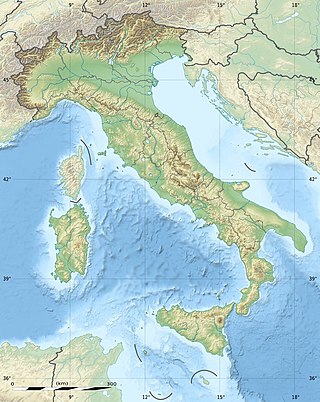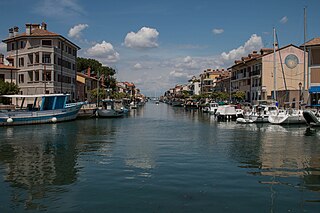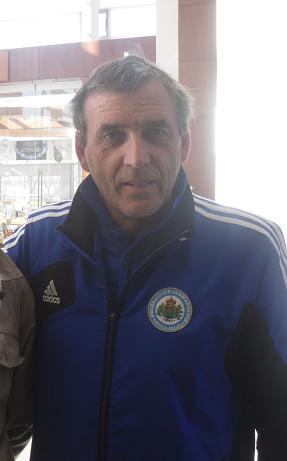
The geography of Italy includes the description of all the physical geographical elements of Italy. Italy, whose territory largely coincides with the homonymous geographical region, is located in southern Europe and comprises the long, boot-shaped Italian Peninsula crossed by the Apennines, the southern side of Alps, the large plain of the Po Valley and some islands including Sicily and Sardinia. Italy is part of the Northern Hemisphere. Two of the Pelagie Islands are located on the African continent.

San Marino is located in Southern Europe, an enclave (landlocked) in central Italy, which it borders for 39 km. The third smallest independent state by area in Europe after the Vatican City and Monaco, San Marino is dominated by the Apennines. Located at 43.94°N 12.46°E, it covers an area of 61.2 km2 (23.6 sq mi). Completely mountainous, only 17% of its territory is arable. Several rivers flow through the country, the largest being the Ausa, the Marano, and the San Marino River.

The Italian Peninsula, also known as the Italic Peninsula,Apennine Peninsula or Italian Boot, is a peninsula extending from the southern Alps in the north to the central Mediterranean Sea in the south.

Grado is a town and comune (municipality) of 8,064 residents in the Regional decentralization entity of Gorizia in the north-eastern Italian region of Friuli-Venezia Giulia, located on an island and adjacent peninsula of the Adriatic Sea between Venice and Trieste. The territory of the municipality of Grado extends between the mouth of the Isonzo and the Adriatic Sea and the Grado Lagoon, and covers an area of about 90 square kilometers between Porto Buso and Fossalon. Characteristic of the lagoon is the presence of the casoni, which are simple houses with thatched roof used in the past by the fishermen of Grado, who remained in the lagoon for a long time, returning to the island of Grado only during the colder period of the year.

The Italian Baseball League, officially known as the Serie A, is the top-level baseball league in Italy. Founded in 1948, it is governed by the Italian Baseball & Softball Federation (FIBS), which has its headquarters in Rome.

Cave is a town and comune in the Latium region of Italy, 42 kilometres (26 mi) southeast of Rome. As of 2011 its population was of 10,421.

This is a list of the extreme points of San Marino: the points that are farther north, south, east or west than any other location.

Novafeltria, historically Mercatino Marecchia, is a comune in the province of Rimini, in the region of Emilia-Romagna, northern Italy.

Monte Titano is a mountain of the Apennines and the highest point in the country of San Marino. It stands 739 m (2,425 ft) above sea level Its peak is located within the municipal limits of the country's capital, San Marino, immediately east of the urbanized area.
The Fiumicello is a river in the Italian peninsula. It rises in San Marino, flowing east to the Italian border. It is a left tributary of the Marano.
The San Marino is a river in the Italian peninsula. It flows through San Marino, then north into Italy. For some of its length it forms part of the border between the two countries. It flows into the Marecchia at Torello, part of the commune of San Leo.

The Ausa is a minor river some 17 kilometres (11 mi) long that traverses part of northern San Marino and Emilia–Romagna in Italy.
The Cando is a river of eastern San Marino. It rises to the east of Monte San Cristoforo, flowing northeast to join with the Marano near the town of Faetano.
Monte San Cristoforo is a mountain of southern San Marino. It is located between the towns of Fiorentino and Montegiardino, and rises to a height of 534 metres.

Giampaolo Mazza is a former manager of the San Marino national football team. Mazza was in charge of the San Marino national team between 1998 and 2013. When not managing the team, Mazza works as a PE teacher at a school near San Marino. A former player who played as a midfielder, he was the longest serving manager in Europe, having spent 15 years managing San Marino. However, he retired in October, 2013 after only winning one game in his tenure.

As San Marino is a microstate completely landlocked by Italy, Sammarinese cuisine is strongly similar to Italian cuisine, especially that of the adjoining Emilia-Romagna and Marche regions. San Marino's primary agricultural products are cheese, wine and livestock, and cheesemaking is a primary economic activity in San Marino. San Marino participated in The Exposition Universelle of 1889, a world's fair held in Paris, France, with three exhibits of oils and cheese.

The Battle of Rimini took place between 13 and 21 September 1944 during Operation Olive, the main Allied offensive on the Gothic Line in August and September 1944, part of the Italian Campaign in the Second World War. Rimini, a city on Italy's Adriatic coast, anchored the Rimini Line, a German defensive line which was the third such line of the Gothic Line defences.

Piazza San Fedele is sited in Milan near Palazzo Marino, the Vittorio Emanuele II Gallery and Piazza della Scala in a pedestrian area in the centre of the city. The square is sited in front of at the homonymous San Fedele Church built based on an old project by Pellegrino Tibaldi in the 16th century and finally consecrated in the 18th century.












